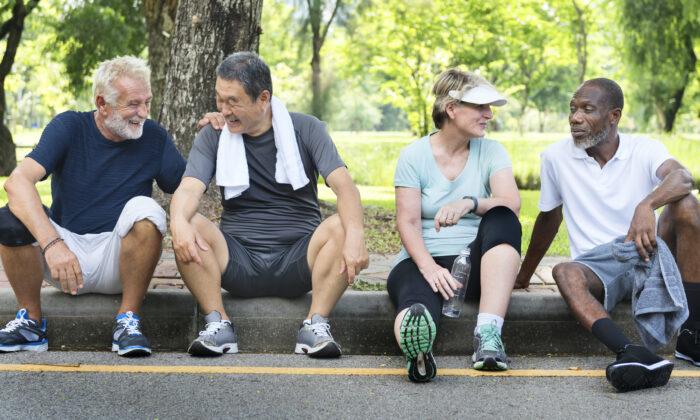Betty Oare
made headlines last year when she and her horse, Sidenote, placed eighth in the Adult Hunter Championship at the Washington International Horse Show in Tyron, North Carolina.
Eighth place may not seem like great shakes. But Oare, who lives in Warrenton, Virginia, and spends two to three hours every day riding Sidenote, was 80 years old. She was competing against athletes young enough to be her grandchildren.
If that’s not enough to inspire you to put away the remote control and get up off the couch, let’s keep digging.
Age Is Just a Frame of Mind
I remember a friend in
college telling me he felt like he had missed out on his life. At 22, he decided he was already superannuated.
“You’re in your early 20s,” I protested.
Max shook his head, remorseful.
“I know,” he sighed. “I’m. Just. So. Old.”
“Age is just a number” is an oft-repeated adage. But the real truth is that age is just a frame of mind. If you consider yourself old, you will act old. Your body will hurt more and you will avoid participating in things that you feel you’re “too old” to do.
But if you realize that your mind is lying to you, that you can do anything you want to do at the age that you are, you will open yourself up to new experiences, new interests, and new passions.
So even if you’ve never walked a mile in your life, it’s not too late to start. And even if you are mobility impaired, or have had a recent illness or operation, you can still become fit. It doesn’t matter if you’re 55 or 85, you aren’t too old—and it isn’t too late.
Running at 59, Marathoning at 90
Just ask Stelios Prassas. Prassas was born in 1931 in Athens. Last year, he was one of some 30,000 participants who ran in the Athens Marathon. He took the same route that was followed by Pheidippides, the herald who brought news of a battle victory from Marathon to Athens during the Persian Wars in 490 B.C. Prassas was 90 years old.Prassas told the
Greek Reporter that he has the mindset and fitness level of a teenager. He listens to what his body and heart tell him, he said.
He grew up playing soccer barefoot on the streets of a very different-looking Athens. But he didn’t start running marathons until he was 59 years old.
Exercising, eating a
plant-based, mostly vegetarian diet, and feeling a deep appreciation for his wife all bring him joy.
“The moment I go to ... work out,” Prassas
told the Reporter, “I feel great love that fills my heart. I feel so much happiness.”
Fitness Matters
We all know the advantages of exercising: moving your body throughout the day ultimately gives you more energy, helps stave off lifestyle-induced diseases including
heart conditions,
obesity, and
adult-onset diabetes.
In June 2020, a team of scientists from Brazil found that exercise even helps
strengthen the immune system, making the body better able to fight COVID-19. Exercising also keeps you from putting on unwanted weight, especially when you exercise
in the morning, and is also protective against
premature death.
Exercise also makes you feel better. While you’re working out, your body makes
endorphins (feel-good hormones) and
endocannabinoids (lipid-based chemical messengers). These beneficial neurotransmitters can help improve every aspect of your mood.
Plus, exercising is fun, and we all need more fun in our lives. It also gives you an excuse to go outside, which has the added benefit of exposing your skin to
sunlight.
And there’s a social component to exercising—especially if you do activities such as playing “
walking soccer,” participating in a senior rowing club, or taking a gentle group fitness class. Exercising can be a good way to meet new people and make new friends.
What’s Holding You Back?
Yes, it’s good for you. Yes, it will make you feel good. So why aren’t you actually exercising? What’s keeping you from getting off the proverbial couch?
Maybe some of these excuses are the ones you are using to stay stationary.
The block: “I feel like I won’t be good at it.” You tell yourself you can’t learn basketball (my personal favorite) at age 65 because ... you won’t be good at it. We use excuses like this to keep ourselves stuck.
The solution: Banish that negative voice. It doesn’t matter whether you’re the next Michael Jordan or you never sink a single shot. What matters is that you’re outside (or at the gym) bouncing that ball and shooting some hoops.
The insight: A key to “successful” exercise as an older adult is to realize that exercise isn’t an expression of your self-worth. It’s not something you have to be “good” at. Instead, it’s something you do for its own internal reward. It will promote your health and happiness—whether you’re “good” at it or not.
The block: “I’m too tired.” Yes, you may get winded more easily. Yes, your body may not be as supple or agile as it once was. But if that isn’t stopping Betty Oare from riding Sidenote or Stelios Prassas from running marathons, it shouldn’t stop you.
The solution: Go at your own pace. Do a little or do a lot. Don’t overdo it, but don’t use feeling tired as a reason not to try.
The block: “I can’t start doing ____ because I’m not in good enough shape.” This is an excuse that a lot of us use to not participate in the sports we once loved.
“I’ll play tennis again once I get back in shape,” a 50-something professor said to me years ago. His words sounded absurd.
The solution: In order to get back into shape, you need to start doing the exercise, sport, or activity you love, not the other way around. Again, baby steps. Start slowly. Pay attention to your body.
The insight: Don’t let the idea that you’re out of shape keep you from getting into shape.
Eating Also Matters
Fitness over 55 is not just about moving throughout the day, it’s also about healthy eating. There’s a feedback loop here: The more you eat foods that optimize your health, the more energy you’ll have to exercise, spend time outside, and try new things. But most of us eat SAD—a Standard American Diet—even when we know it isn’t the best way to optimize our health.This is where we need to look to blue zones, our ancestors, and Asian cultures to fix what’s broken about our food habits. People in blue zones live longer than people elsewhere, and that includes Okinawa, Japan. When my friend’s four children were going to school in Japan, snacks were always whole foods in season: daikon radishes, for example, or Satsuma mandarins.
In Japan, which is considered one of the healthiest, if not the
healthiest country in the world (the Japanese
life expectancy is among the highest while obesity rates are among the lowest), people also tend to eat more moderately, much like Westerners used to.
Hara Hachi Bu
Instead of making themselves unpleasantly full with food, the Japanese strive to practice a concept called “hara hachi bu,” which translates into eating only until you’re 80 percent full.
This idea comes originally from Okinawa, the Japanese island with an astonishing number of healthy centenarians.
Try it. Your stomach may growl in protest at first, but once you get used to eating without overeating, you'll likely find that your food is tastier and your mealtimes are more enjoyable.
It’s important, too, to choose fresh, seasonal, whole foods whenever possible. The SAD or SWD (Standard Western Diet) often is high in heavily processed refined grains (such as white pasta, bagels, and white bread) and high in refined sugars. These food choices cause the levels of sugar in our bloodstreams to first spike and then plummet, leading to a ping-pong effect that puts stress on our adrenals, negatively affects our mood, and predisposes us to diabetes.
Instead of packaged, highly processed foods containing high amounts of sugar and unhealthy nonfood additives, choose fresh seasonal
vegetables and fruits, legumes, nuts,
fermented foods, wild-caught fish, a moderate amount of grains, pasture-raised grass-finished meats (if you eat meat), and indulge only in homemade sweets.
Getting Started
You’re ready. You want to
change your lifestyle habits and start a fitness routine. You’re committed to moving more throughout the day, throwing away the unhealthy foods in your cupboards, and being more active.
So now what?
Sign up for a class: Your local senior center or OLLI (
Osher Lifelong Learning Institute) offers free or very affordable classes to older adults. Sign up for an activity such as birdwatching or English country dancing, where you learn new skills while being active. The nice thing about doing it this way is that it allows you to get fit without you even realizing it.
Try different activities: It may take a while to find the fitness activity that you like best. Maybe you’ll discover an unexpected fondness for running, or maybe stationary bicycling is more your thing. If you’re a social person, try pickleball. If you’d rather have a head cold than talk to other people, a solo sport such as cross-country skiing or hiking in the woods may the best choice.
Find a buddy: An accountability or exercise buddy will help you keep your momentum. Find a friend or relative who also has a goal (which may or may not be related to fitness), and set up a system where you check in on each other to monitor your daily progress.
If that’s not enough to keep you on task, make it into a higher-stakes game. You each put money in a kitty. Whoever achieves his or her weekly goal gets the kitty that week. If you both fail, you give the money to your favorite charity and try again.
Aim for the a.m.: “A day that you exercise in the morning is a day that you exercise” is one of my 80-something father’s favorite pearls of wisdom. This is a good insight. Besides, there may be more benefit to exercising in the morning, before you’ve eaten anything, than at other times of day. Research has consistently shown that there are myriad health benefits to fasting exercise. For example, one
study done by scientists at the University of Leuven in Belgium that was published in the Journal of Physiology showed that exercise done before breakfast burns more fat and regulates insulin levels more effectively than exercising after you’ve eaten.
Now lace up those sneakers, and go for that slow jog.






